- About Us
- Columns
- Letters
- Cartoons
- The Udder Limits
- Archives
- Ezy Reading Archive
- 2024 Cud Archives
- 2023 Cud Archives
- 2022 Cud Archives
- 2021 Cud Archives
- 2020 Cud Archives
- 2015-2019
- 2010-2014
- 2004-2009
 |
Five Rooms Isn't That Puzzling... |
There’s this fun brainteaser called the “Five Rooms Puzzle.” The basic gist is that there are five rooms—two on the top, three on the bottom, all abutting. The challenge: Draw a continuous line with your pen that passes through each of the sixteen walls of the puzzle—without picking up your pen and without crossing any wall more than once.
I remember learning this from David Jackson, one of my favorite high-school teachers, around 1985. He drew it on the chalkboard and many of us tried like hell to solve it. After a zillion tries, I never solved it, but I always came so damn close that I was sure that there was an evasive solution.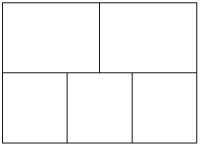
After a few days of furiously trying, Mr. Jackson informed us that there was no solution under the puzzle’s rules. Regardless, I still doodled it on occasion after that, usually when showing some other poor, unsuspecting soul and watching in amusement as he went nuts trying to solve it. I did eventually come to a simple mathematical epiphany about why it wasn’t possible, but we’ll get to that later.
There’s a typical progression that someone goes through in trying to solve the puzzle. First, he draws it repeatedly, convinced that there really is a solution. He frequently completes it and shouts, “Eureka!” before he realizes that he missed a wall or crossed one twice. Then, after being informed that the puzzle is impossible, he’s extra-determined to do it anyway by treating it as a riddle and twisting the rules. He folds the paper. He pokes holes in it to draw his line underneath a wall, or he draws off the paper and around the back. He wraps the paper around a cylinder or declares that he can do it if it’s three-dimensional. He traces along a wall instead of crossing it, or he draws his line through an intersection and claims that he hit two or three walls at once. He makes the puzzle tiny and uses a fat marker to draw a line across the whole thing. And so on.
By now, if you’ve never done the puzzle before, you’ve probably grabbed a piece of paper, drawn out the five rooms, and tried it. If you haven’t, stop reading right now and give it a whirl. If you believe that you’ll be the miracle-worker who defies the laws of mathematics and can solve it, you’re wrong. And if you realize that the puzzle is indeed unsolvable, then you’ll be ready to keep reading as I get to my point.
Go ahead. I’ll wait.
* * *
You’re likely in one of two states right now. If you understand the impossibility of the puzzle, congratulations. If you firmly believe that you’ve solved it, let me be clear: You didn’t.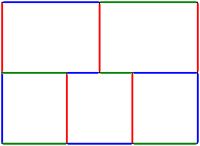
The images with this column clearly illustrate the puzzle. The first one is the basic drawing of the five rooms. The next one, with the colored lines, show you each of the walls to be passed through. The horizontal line above the bottom-center room catches a lot of people, since everyone forgets that that’s two separate walls.
The third image shows red dots at the centers of the sixteen walls. This is helpful for visualizing, especially for those daredevils who insist on tracing along walls or cutting through corners. The fourth is even better, showing doorways between the rooms, with the rule that you must not touch any of the lines and draw your line only through each doorway. That one makes it harder to come up with clever cheats.
The final three images show various attempts. The first is a by-the-rules failure, with one wall missed. The next shows an illegal wall tracing. The last shows cutting through a corner to claim multiple walls, which is also illegal.
In 1985, without understanding the math and without having an Internet to research it, we were left to draw and wonder. Of course, that’s all different today. Type in “five room puzzle” into a search engine and you’ll find a gazillion results, virtually all with the same summation: It cannot be done. Corollaries usually follow: It can only be done if you change the rules.
If you adhere to the puzzle’s simple rules, you cannot solve it. That’s the point. That’s why there are rules. But what you’ll often see are people claiming, “Well, the rules don’t SAY you can’t go through a corner!” 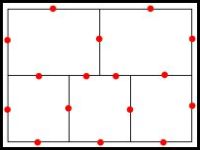 That’s like saying “The rules of baseball don’t SAY that I can’t get an automatic do-over on a third-strike swing if I run to third base and back, so I should be able to do it!”
That’s like saying “The rules of baseball don’t SAY that I can’t get an automatic do-over on a third-strike swing if I run to third base and back, so I should be able to do it!”
A while back, I stumbled across several YouTube videos of this puzzle, and the comments people were leaving really struck me. I know, it’s the Internet; they let any idiot with a keyboard say anything he wants to, and anonymity breeds courage and horrible behavior, so why be surprised? Well, this is something of a unique case. Consider some of the typical sorts of comments:
“Easy, did it first try.” No, you didn’t. Look again.
“I’m only eleven and I got it in two minutes.” You did not. Check your work, and know that when you turn twelve, you’ll still be unable to solve it.
“This is kid’s stuff. I did this when I was in third grade.” I call bullshit. But thanks for playing.
“I’ve done it. I’ll upload a pic soon.” But you never uploaded the pic of the solved puzzle. This is because no such pic can possibly exist.
“I’ve done it. Here’s my pic.” How triumphant! But you [missed a wall] / [went through a wall twice] / [cheated]. Back to the drawing board.
“I have a book that proves it can be done, and here’s a pic of the pages in the book.” No, the book shows how to cheat. Try again. Better yet, don’t bother. Why? Can’t be done.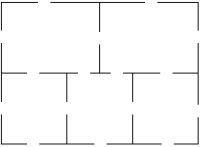
But these comments aren’t nearly as interesting as their replies and the ensuing conversations. Invariably, someone declares it solved or possible, and people who know otherwise answer with mathematical explanations and links to Web sites that explain it. But the commenter often refuses to listen; he steadfastly maintains that the math and the mathematicians are wrong, and that he has given the world a miracle. These people aren’t generally trolling; no, they simply believed that it’s solvable and ran their mouths before actually solving it.
All right: What the hell is this column about? A puzzle? Math? Annoying people online?
It’s all those things, but it’s something more. Here we have a puzzle that can no more be solved than someone could prove that two plus two equals five. People who proclaim that it’s solvable refuse to admit otherwise, and in doing so display a level of egotism that is so far out of balance as to be alarming. Is this the result of a world that is careening ever faster into a reality where children are always right, who get ribbons just for participating, and have parents worship them on pedestals? Has this impacted the basic skills of logic, reason, and critical thinking that our brains have evolved to have over every other living thing on the planet?
Then come the rule changes. Some people claim to have solved it but have done so by folding the paper, drawing through corners, and all the other cheats. They claim that they’re thinking outside the box, as if this is a clever riddle, despite it being nothing more than a really simple set of instructions. But they can’t accept that. They fiercely defend their way of doing it because the rules don’t say they can’t. It doesn’t matter how many people are trying like hell to explain why it’s mathematically impossible; everyone using logic and math is wrong, and that’s all there is to it. This is a disturbing level of inability to accept that one is mistaken. Is this the result of a life of entitlement to the umpteenth degree? Are people so weak-minded that they cannot—that they WILL NOT—accept when they’re wrong? Worse yet, do they believe that there’s no way that they can possibly be wrong?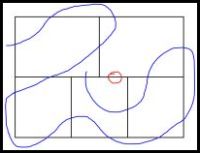
Perhaps most unsettling are those whose first posts are something like “Did it on the first try. You people are fucking stupid.” You might expect this sort of classless stooping during a raging political or religious debate—but not in a first post to a forum of strangers. But this isn’t about which god will win in a fistfight. It’s a puzzle. That’s it. Nothing more. But these people start with vicious language and unprovoked attacks on complete strangers. It might seem easier to just ignore such childish behavior, but there are more serious ramifications here. That’s a frightening level of hate, ego, righteousness, and bad manners. What were these people like on the playground? Are they always that way, or only when they hide behind online anonymity?
It’s possible, or indeed likely, that they behave this way mostly because of that anonymity. But I doubt that their “real” vs. “online” personas are really Jekyll and Hyde. These are the people they really are, with any semblance of restraint tossed aside. Of course, vicious, hateful, and stupid comments online are nothing new. But to see it repeatedly displayed by so many over something as silly as this puzzle is deeply troubling. Are we really becoming a civilization of hateful, egocentric, arrogant, spoiled, entitled, rude, stupid, boorish people? Should we all hail Homo anonymous?
This alarming behavior epitomizes the ongoing social failure of so many things. We have people devoid of critical-thinking skills. They don’t understand the scientific method. They aren’t interested in doing a minute of research to understand why the puzzle cannot be solved. They ignore offered explanations and directions to proofs. They only sit at their keyboards making wild declarations of their impossible skills, of their disdain for people who disagree with them, and of their insistence of claiming victory at all costs.
All over a puzzle. You might get it when people scream at each other about politics or religion—hell, even football or NASCAR or whether McDonald’s is any good—but over a puzzle with solid math and a simple explanation? How on Earth can this puzzle justify such runaway primitive behavior?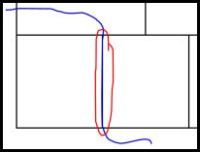
This is a shining example of what we need to do to prepare kids for the real world. In school, they need to learn critical-thinking skills. If more of them do, we’ll have more adults who can think about things logically and reasonably. That might lead to some great things, like a civilization where people don’t declare climate change is a hoax or evolution is wrong. Maybe they’ll reconsider stories of magical beings who live in the sky or understand that the Earth is more than six thousand years old. Maybe they’ll focus on thinking instead of hating and oppressing and waging war.
But school is just the beginning. At home, families need to do their part. They need to teach respect, manners, and kindness. That will go a long way towards forging adults who aren’t hateful and rude, insulting and boorish, too much Hulk and not enough Bruce Banner.
Seriously, people, if you can’t put some real effort into rearing children who at least have the basic social skills to interact with others, please don’t reproduce. It isn’t fair to civilization. And if the schools aren’t teaching critical thinking, there’s no point in graduating students whose ability to understand the world around them is already lost.
* * *
About the math: Put simply, since three of the rooms have odd numbers of walls, and you must go in AND out of each room, there’s no way to solve this puzzle under the rules. If you only had one five-walled room, you could do it, but not with more than one.
But the Five-Room Puzzle is an invaluable tool for teaching critical-thinking skills, mathematics, graph theory, Eulerian paths, and other fascinating bits of logic and reason. If people learn WHY it’s impossible, they’ll be making better use of their brains. For better mathematical insight:
https://en.wikipedia.org/wiki/Five_room_puzzle
http://mathtrivia.blogspot.com/2011/06/explanation-on-5-room-house-puzzle.html
http://www.archimedes-lab.org/How_to_Solve/5_rooms.html
And if you’re getting some evil-genius glee watching someone going mad trying to solve the unsolvable even when you’ve tried to explain that it’s impossible, tell him about the Seven Bridges of Königsberg puzzle and let him go nuts over that for a while:
https://en.wikipedia.org/wiki/Seven_Bridges_of_Königsberg
David M. Fitzpatrick is a fiction writer in Maine, USA. His many short stories have appeared in print magazines and anthologies around the world. He writes for a newspaper, writes fiction, edits anthologies, and teaches creative writing. Visit him at www.fitz42.net/writer to learn more.
